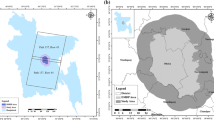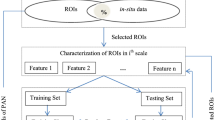Abstract
Land cover assessment and monitoring are essential for sustainable management of natural resources and environmental protection. Object-based image analysis (OBIA) for land cover classification has become an area of interest due to its superiority over the pixel-based classification method. The main objective of this paper is developing a method for land cover classification on the national and sub-national level in the Republic of North Macedonia for mapping and monitoring the land cover changes in the study area from 1988 to 2014. For that purpose, in this study, we combine OBIA with rule set semi-automated multi-segmentation classification for large-scale areas over medium-resolution satellite imagery. Thus, Landsat image collections over North Macedonia have been combined with topographic and settlement layers for land cover classification. Based on the knowledge of certain land cover features, rule-based classification has been developed using two different segmentation parameters. The results show that the overall agreement of the new semi-automatic classification method developed for North Macedonia is 83%. The most significant change in the land cover can be noticed in the forest class, with a total increase of 8% on national and 15% in the South-East region. These results confirm that this new semi-automatic, cost-effective, and accurate land cover classification method can be easily employed and adjusted for different study areas and can be used in numerous remote sensing applications.





Similar content being viewed by others
References
Abdollahi A, Pradhan B, Shukla N, Chakraborty S, Alamri A (2020) Deep learning approaches applied to remote sensing datasets for road extraction: a state-of-the-art review. Remote Sens 12:1444
Al-Najjar HA, Kalantar B, Pradhan B, Saeidi V, Halin AA, Ueda N, Mansor S (2019) Land cover classification from fused DSM and UAV images using convolutional neural networks. Remote Sens 11:1461
Banko G (1998) A review of assessing the accuracy of classifications of remotely sensed data and of methods including remote sensing data in forest inventory
Benz UC, Hofmann P, Willhauck G, Lingenfelder I, Heynen M (2004) Multi-resolution, object-oriented fuzzy analysis of remote sensing data for GIS-ready information. ISPRS J Photogramm Remote Sens 58:239–258
Caetano M, Nunes V, Nunes A (2009) CORINE land cover 2006 for continental Portugal Relatório Técnico, Instituto Geográfico Português
Cai L, Shi W, Miao Z, Hao M (2018) Accuracy assessment measures for object extraction from remote sensing images. Remote Sens 10:303
Cardillo G (2020) Giuseppe Cardillo (2020). Cohen’s kappa (https://www.github.com/dnafinder/Cohen), GitHub. Retrieved May 19, 2020
Corbane C, Politis P, Pesaresi M, Kemper T, Siragusa A (2018) Estimation of land use efficiency from the Global Human Settlement Layer (GHSL) QGIS and applications in territorial planning. 3:39–52
Corbane C et al (2020) The grey-green divide: multi-temporal analysis of greenness across 10,000 urban centres derived from the Global Human Settlement Layer (GHSL). Int J Digit Earth 13:101–118
Donev D (2014) Rural landscapes along the Vardar Valley: two site-less surveys near Veles and Skopje, the Republic of Macedonia. Faculty of Archaeology, Leiden University
Emanuel RE (2018) Climate change in the Lumbee River watershed and potential impacts on the Lumbee tribe of North Carolina. J Contemp Water Res Educ 163:79–93
Fernández Nogueira D, Corbelle Rico E (2019) Determinants of land use/cover change in the Iberian Peninsula (1990–2012) at municipal level
Georgieva V, Konechni S (1998) Historical dictionary of the Republic of Macedonia. vol 22. Scarecrow Pr,
Gilani H, Shrestha HL, Murthy M, Phuntso P, Pradhan S, Bajracharya B, Shrestha B (2015) Decadal land cover change dynamics in Bhutan. J Environ Manag 148:91–100
Gorelick N, Hancher M, Dixon M, Ilyushchenko S, Thau D, Moore R (2017) Google Earth Engine: planetary-scale geospatial analysis for everyone. Remote Sens Environ 202:18–27
Gulácsi A, Kovács F (2020) Sentinel-1-imagery-based high-resolution water cover detection on wetlands, Aided by Google Earth Engine. Remote Sens 12:1614
Hermosilla T, Wulder MA, White JC, Coops NC, Hobart GW (2015) Regional detection, characterization, and attribution of annual forest change from 1984 to 2012 using Landsat-derived time-series metrics. Remote Sens Environ 170:121–132
Homer C, Dewitz J, Jin S, Xian G, Costello C, Danielson P, Gass L, Funk M, Wickham J, Stehman S, Auch R, Riitters K (2020) Conterminous United States land cover change patterns 2001–2016 from the 2016 National Land Cover Database. ISPRS J Photogramm Remote Sens 162:184–199
Hossain MD, Chen D (2019) Segmentation for object-based image analysis (obia): a review of algorithms and challenges from remote sensing perspective. ISPRS J Photogramm Remote Sens 150:115–134
Huang C, Goward SN, Schleeweis K, Thomas N, Masek JG, Zhu Z (2009) Dynamics of national forests assessed using the Landsat record: Case studies in eastern United States. Remote Sens Environ 113:1430–1442
Jawarneh RN, Biradar CM (2017) Decadal national land cover database for Jordan at 30 m resolution. Arab J Geosci 10:483
Jensen JR (1996) Introductory digital image processing: a remote sensing approach. Prentice Hall, Upper Saddle River, p 7458
Jiang M, Li X, Xin L, Tan M (2019) Paddy rice multiple cropping index changes in Southern China. J Geogr Sci 29:1773–1787
Jin S et al (2019) Overall methodology design for the United States National Land Cover Database 2016 Products. Remote Sens 11:2971
Juan AA (2016) Correction: Juan, AA; Mendez, CA; Faulin, J.; de Armas, J.; Grasman, SE Electric vehicles in logistics and transportation: a survey on emerging environmental, strategic, and operational challenges. Energies 2016, 9, 86 Energies 9:1-1
Kaplan G, Avdan U (2017a) Object-based water body extraction model using Sentinel-2 satellite imagery Eur. J Remote Sens 50:137–143
Kaplan G, Avdan U (2017b) Water extraction technique in mountainous areas from satellite images. J Appl Remote Sens 11:046002
Knorn J, Rabe A, Radeloff VC, Kuemmerle T, Kozak J, Hostert P (2009) Land cover mapping of large areas using chain classification of neighboring Landsat satellite images. Remote Sens Environ 113:957–964
Kucsicsa G, Popovici E-A, Bălteanu D, Grigorescu I, Dumitraşcu M, Mitrică B (2019) Future land use/cover changes in Romania: regional simulations based on CLUE-S model and CORINE land cover database. Landsc Ecol Eng 15:75–90
Kwan C et al (2020) Deep learning for land cover classification using only a few bands. Remote Sens 12:2000
McFeeters SK (1996) The use of the Normalized Difference Water Index (NDWI) in the delineation of open water features. Int J Remote Sens 17:1425–1432
Ocer NE, Kaplan G, Erdem F, Kucuk Matci D, Avdan U (2020) Tree extraction from multi-scale UAV images using Mask R-CNN with FPN. Remote Sens Lett 11:847–856
Oliphant AJ, Thenkabail PS, Teluguntla P, Xiong J, Gumma MK, Congalton RG, Yadav K (2019) Mapping cropland extent of Southeast and Northeast Asia using multi-year time-series Landsat 30-m data using a random forest classifier on the Google Earth Engine Cloud. Int J Appl Earth Obs Geoinf 81:110–124
Pesaresi M, Freire S (2016) GHS Settlement grid following the REGIO model 2014 in application to GHSL Landsat and CIESIN GPW v4-multitemporal (1975-1990-2000-2015) European Commission JRC
Pesaresi M, Melchiorri M, Alice S, Kemper T (2016) Atlas of the human planet 2016: mapping human presence on earth with the global human settlement layer. Publications Office,
Pettorelli N, Vik JO, Mysterud A, Gaillard J-M, Tucker CJ, Stenseth NC (2005) Using the satellite-derived NDVI to assess ecological responses to environmental change. Trends Ecol Evol 20:503–510
Popovici EA, Bălteanu D, Kucsicsa G (2013) Assessment of changes in land-use and land-cover pattern in Romania using Corine Land Cover Database Carpath. J Earth Env 8:195–208
Pradhan B, Al-Najjar HA, Sameen MI, Tsang I, Alamri AM (2020) Unseen land cover classification from high-resolution orthophotos using integration of zero-shot learning and convolutional neural networks. Remote Sens 12:1676
Pravalie R, Sîrodoev I, Peptenatu D (2014) Detecting climate change effects on forest ecosystems in Southwestern Romania using Landsat TM NDVI data. J Geogr Sci 24:815–832
Schiavina M, Melchiorri M, Corbane C, Florczyk AJ, Freire S, Pesaresi M, Kemper T (2019) Multi-scale estimation of land use efficiency (SDG 11.3. 1) across 25 years using global open and free data. Sustainability 11:5674
Sheykhmousa M, Mahdianpari M, Ghanbari H, Mohammadimanesh F, Ghamisi P, Homayouni S (2020) Support vector machine vs, Random forest for remote sensing image classification: a meta-analysis and systematic review. IEEE J Sel Top Appl Earth Obs Remote Sens
Thunnissen H, De Wit A (2000) The national land cover database of the Netherlands. In: Geoinformation for all; XIXth congress of the International Society for Photogrammetry and Remote Sensing (ISPRS). vol B7/3. pp 223-230
Xian G, Homer C, Fry J (2009) Updating the 2001 National Land Cover Database land cover classification to 2006 by using Landsat imagery change detection methods. Remote Sens Environ 113:1133–1147
Xu Y, Wu L, Xie Z, Chen Z (2018) Building extraction in very high resolution remote sensing imagery using deep learning and guided filters. Remote Sens 10:144
Yan G, Mas JF, Maathuis B, Xiangmin Z, Van Dijk P (2006) Comparison of pixel-based and object-oriented image classification approaches—a case study in a coal fire area, Wuda, Inner Mongolia, China. Int J Remote Sens 27:4039–4055
Yang L, Jin S, Danielson P, Homer C, Gass L, Bender SM, Case A, Costello C, Dewitz J, Fry J, Funk M, Granneman B, Liknes GC, Rigge M, Xian G (2018) A new generation of the United States National Land Cover Database: requirements, research priorities, design, and implementation strategies. IISPRS J Photogramm Remote Sens 146:108–123
Yin H et al (2020) Monitoring cropland abandonment with Landsat time series. Remote Sens Environ 246:111873
Zhang Q, Chen Y, Li Z, Li Y, Xiang Y, Bian W (2019) Glacier changes from 1975 to 2016 in the Aksu River Basin, Central Tianshan Mountains. J Geogr Sci 29:984–1000
Acknowledgments
The study has been prepared within the scope of Macedonia’s Fourth National Communication and Third Biennial Update Report on Climate Change under the UNFCCC.
Author information
Authors and Affiliations
Corresponding author
Additional information
Responsible Editor: Biswajeet Pradhan
Rights and permissions
About this article
Cite this article
Kaplan, G. Semi-automatic multi-segmentation classification for land cover change dynamics in North Macedonia from 1988 to 2014. Arab J Geosci 14, 93 (2021). https://doi.org/10.1007/s12517-020-06347-x
Received:
Accepted:
Published:
DOI: https://doi.org/10.1007/s12517-020-06347-x




